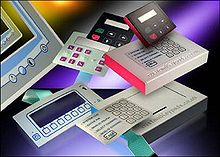- Membrane switch
-
A membrane switch is an electrical switch for turning a circuit on and off. It differs from a mechanical switch, which is usually made of copper and plastic parts: a membrane switch is a circuit printed on PET or ITO. The ink used for screen printing is usually copper / silver / graphite filled and therefore conductive.
Construction
The ASTM defines a membrane switch as "a momentary switch device in which at least one contact is on, or made of, a flexible substrate."
A membrane switch typically has 4 or more layers. The top layer of a membrane switch is the graphic interface between the user and the machine. The other critical layer is a printed circuit. This can also be a flex circuit made of copper and polyimide material. The layers are normally assembled using pressure sensitive adhesives although inexpensive designs can be held together through other mechanical means such as a keyboard housing. Contact between two traces can be made through a printed shorting pad or through a metal dome that stands on legs.
Backlighting
There are three standard methods for backlighting membrane switches.
The first option is using Light Emitting Diodes (LEDs) to backlight. However, LEDs create bright spots and are not suitable for overall backlighting of a panel, but rather as indicator lights. LEDs can either be surface-mounted to the circuit layer or be placed on a separate LED layer.
A second option is optical fiber. In a typical design, two or more layers of woven fiber-optic cloth are used to form a rectangular light-emitting area. The fibers coming off one end are then bundled into a circular ferrule and coupled to one or more LED light sources. Remote light sources offer 10,000 to 100,000 hours of life. Optical fibers are not affected by extremes in humidity (0% to 100%) or temperature (-40 to +85 deg C).
The third standard option is to use electroluminescent (EL) lamps. They are lower priced compared to fiber optics and offer additional design flexibility. The color of light emitted from an EL lamp can vary depending on the phosphors that are used. Some common colors are blue/green and yellow/green, white, blue and orange. EL lamps have a half life of approximately 3000-8000 hours depending upon the quality of the phosphor. Once they reach their half life, the brightness starts to fade rapidly. EL lamps are thus not a good choice if the lamp is on for an extended period of time. Fading or flashing could double the life of the lamp.
Applications
Classic applications of membrane switches include microwave oven panel, air conditioner control panel, TV remote control etc. Tactile feedback of keys can be provided by embossing the top PET layer or embedding metal snap domes, polyester domes or forming the graphic layer.
The benefits of membrane switches include ease of cleaning, sealing ability and their low profile.
Categories:- Electrical engineering
- Electronics stubs
Wikimedia Foundation. 2010.

